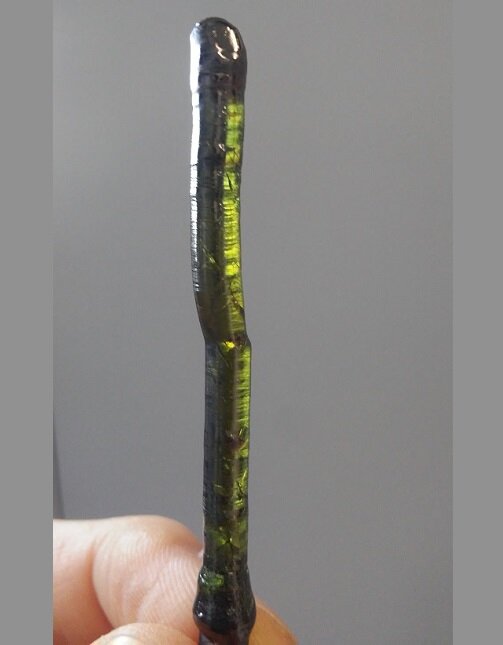博文
首次观测到物质的异常量子态
 精选
精选
||
首次观测到物质的异常量子态
诸平

据加拿大蒙特利尔大学(University of Montreal)2022年5月11日提供的消息,加拿大、美国、德国以及法国的科研人员合作,首次观测到物质的异常量子态(Unusual quantum state of matter observed for the first time)。
量子物理学是一个致力于描述原子和亚原子粒子的行为,以阐明它们的性质的科学领域,并不是每天都有人遇到物质的新状态。然而,一个由加拿大、美国、德国以及法国的科研人员组成的国际研究团队,他们首次观测到物质的新状态——异常量子态(Unusual quantum state)。该团队包括加拿大蒙特利尔大学物理学教授、加拿大北魁克先进材料分组(Regroupement Québécois sur les Matériaux de Pointe)的研究员安德里亚•比安奇(Andrea Bianchi),以及他的学生阿夫纳•菲特曼(Avner Fitterman)和杰雷米·杜德梅因(Jérémi Dudemaine)等人。相关研究结果于2022年4月20日已经在《物理评论X》(Physical Review X)杂志网站发表——E. M. Smith, O. Benton, D. R. Yahne, B. Placke, R. Schäfer, J. Gaudet, J. Dudemaine, A. Fitterman, J. Beare, A. R. Wildes, S. Bhattacharya, T. DeLazzer, C. R. C. Buhariwalla, N. P. Butch, R. Movshovich, J. D. Garrett, C. A. Marjerrison, J. P. Clancy, E. Kermarrec, G. M. Luke, A. D. Bianchi, K. A. Ross, B. D. Gaulin. Case for a U(1)π Quantum Spin Liquid Ground State in the Dipole-Octupole Pyrochlore Ce2Zr2O7. Physical Review X, 2022, 12(2): 021015 – Published 20 April 2022. DOI: 10.1103/PhysRevX.12.021015
在此文中,研究人员在安德里亚•比安奇的实验室创造的磁性材料Ce2Zr2O7中记录了“量子自旋液体基态”, Ce2Zr2O7是一种由铈、锆和氧组成的化合物。上述来自蒙特利尔大学的图片,是安德里亚•比安奇实验室设计的一种受挫的铈基磁体样品,Ce2Zr2O7。
参与此项研究的除了来自蒙特利尔大学和加拿大北魁克先进材料分组的研究人员之外,还有来自加拿大麦克马斯特大学(McMaster University, Hamilton, Ontario, Canada)、德国马克斯·普朗克复杂系统物理研究所(Max Planck Institute for the Physics of Complex Systems, Dresden, Germany)、美国科罗拉多州立大学(Colorado State University, USA)、法国劳厄-郎之万研究所(Institut Laue-Langevin, France)、法国巴黎-萨克雷大学(Université Paris-Saclay, France)、美国国家标准与技术研究所中子研究中心(Center for Neutron Research, National Institute of Standards and Technology, Maryland, USA)、美国洛斯阿拉莫斯国家实验室(Los Alamos National Laboratory, New Mexico, USA)以及加拿大高等研究院(Canadian Institute for Advanced Research)的研究人员。
就像液体被锁在极冷的固体里(Like a liquid locked inside an extremely cold solid)
在量子物理学(quantum physics)中,自旋是一种与电子旋转有关的内部属性。正是自旋使磁体中的材料具有磁性。在一些材料中,自旋会导致无序结构,类似于液体中的分子,因此有了“自旋液体(spin liquid)”的说法。
一般来说,随着温度的升高,材料的组织会变得更加混乱。例如,当水变成蒸汽时就是这样。但自旋液体的主要特点是,即使冷却到绝对零度(-273 ℃),它们仍然是无序的。
自旋液体仍然是无序的,因为随着材料冷却,自旋的方向继续波动,而不是像传统磁体那样稳定在固体状态(solid state),在这种状态下,所有自旋都是对齐的。
“受挫”电子的艺术(The art of 'frustrating' electrons)
把电子想象成一个小小的指南针,它可以指向上方或下方。在传统磁体中,电子自旋的方向都是相同的,向上或向下,这就形成了所谓的“铁磁相(ferromagnetic phase)”。这就是把照片和便条用磁铁别在冰箱上的方法。
但在量子自旋液体中,电子被放置在一个三角形晶格中,形成一个“三人之家(ménage à trois)”,其特征是强烈的湍流干扰了它们的顺序。结果是无磁序的纠缠波函数(entangled wave function)。
安德里亚•比安奇解释说:“当加入第三个电子时,电子的自旋不能对齐,因为相邻的两个电子的自旋总是相反的,这就产生了我们所说的磁阻挫(magnetic frustration)。这产生了能保持自旋无序的激发,因此即使在非常低的温度下也能保持液态。”
那么它们是如何添加第三个电子并引起如此大的受挫的呢?
创建“三人之家”( Creating a ménage à trois)
安德里亚•比安奇在他的实验室里创造了一个受挫的磁体(frustrated magnet)Ce2Zr2O7。他在开发超导体等先进材料( advanced materials)方面已经取得了斐然成绩,现在我们可以再加上一个“受挫磁体艺术大师(master of the art of frustrating magnets)”的头衔。
Ce2Zr2O7是一种具有磁性的铈基材料。“这种化合物的存在是已知的,”安德里亚•比安奇说,“我们的突破是创造了一种独特的纯粹形式。我们使用在光学炉中熔化的样品来产生近乎完美的原子三角形排列,然后检查量子态。”
正是这种近乎完美的三角形使安德里亚•比安奇和他在蒙特利尔大学(UdeM)的团队能够在Ce2Zr2O7中创造磁阻挫(magnetic frustration)。他们与麦克马斯特大学、科罗拉多州立大学、洛斯阿拉莫斯国家实验室和德国德累斯顿(Dresden)的马克斯·普朗克复杂系统物理研究所的研究人员合作,测量了这种化合物的磁扩散。
安德里亚•比安奇说:“我们的测量显示了重叠的粒子功能——因此没有布拉格峰(Bragg peaks)——这是古典磁秩序缺失的明显迹象。我们还观察到方向连续波动的自旋分布,这是自旋液体和磁阻挫的特征。这表明我们创造的材料在低温下表现得像真正的自旋液体。”
从梦想到现实(From dream to reality)
在用计算机模拟(computer simulations)证实了这些观察后,研究小组得出结论,他们确实目睹了一种从未见过的量子态。
安德里亚•比安奇说:“对每一位物理学家来说,发现一种新的量子状态是梦想成真。我们的材料是革命性的,因为我们是第一个证明它确实可以作为自旋液体呈现的材料。这一发现可能为设计量子计算机的新方法打开大门。”
受挫磁铁简介(Frustrated magnets in a nutshell)
磁性是一种集体现象,在这种现象中,材料中的电子都以同一方向自旋。铁磁体就是一个很常见的例子,它的磁性源于自旋的排列。相邻的电子也可以向相反的方向自旋。在这种情况下,自旋仍然有明确的方向,但没有磁化。受挫的磁体之所以受挫,是因为邻近的电子试图将它们的自旋定向到相反的方向,当它们发现自己处于三角形晶格(triangular lattice)中时,它们就不能再固定在一个共同的、稳定的排列上。结果成为一块受挫的磁体(a frustrated magnet)。
上述介绍,仅供参考。欲了解更多信息,敬请注意浏览原文或者相关报道。
计算侦查证实了第一个三维量子自旋液体(Computational sleuthing confirms first 3D quantum spin liquid)
量子自旋液体(quantum spin liquid)的相关研究概述
The Ce3+ pseudospin-1/2 degrees of freedom in the pyrochlore magnet Ce2Zr2O7 are known to possess dipole-octupole character, making it a candidate for novel quantum spin liquid ground states at low temperatures. We report new polarized neutron diffraction at low temperatures, as well as heat capacity (Cp) measurements on single crystal Ce2Zr2O7. The former bears both similarities and differences with that measured from the canonical dipolar spin ice compound Ho2Ti2O7, while the latter rises sharply at low temperatures, initially plateauing near 0.08 K, before falling off toward a high temperature zero beyond 3 K. Above~0.5 K, the Cp dataset can be fit to the results of a quantum numerical linked cluster calculation, carried out to fourth order, that allows estimates for the terms in the near-neighbor XYZ Hamiltonian expected for such dipole-octupole pyrochlore systems. Fits of the same theory to the temperature dependence of the magnetic susceptibility and unpolarized neutron scattering complement this analysis. A comparison between the resulting best-fit numerical linked cluster calculation and the polarized neutron diffraction shows both agreement and discrepancies, mostly in the form of zone-boundary diffuse scattering in the non-spin-flip channel, which are attributed to interactions beyond near neighbors. The lack of an observed thermodynamic anomaly and the constraints on the near-neighbor XYZ Hamiltonian suggest that Ce2Zr2O7 realizes a U(1)π quantum spin liquid state at low temperatures, and one that likely resides near the boundary between dipolar and octupolar character.
https://blog.sciencenet.cn/blog-212210-1338305.html
上一篇:现代量子技术的进步:任意波长的单个光子的频率转换
下一篇:量子自旋液体的相关研究概述